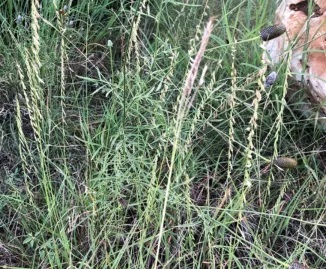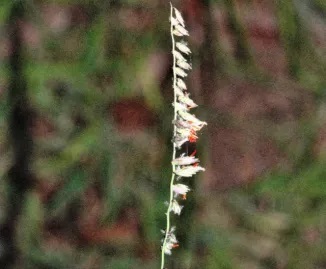NICE! Plant of the Month
(Bouteloua curtipendula)


Family: Poaceae
Other Common Names:Banderilla, Banderita, Navajita
Type: Perennial grass
Growth: Upright to one meter tall
Natural Habitat: Prairies, dry grassland, rocky slopes, hilltops, woodlands
Deer Resistance: High
Wildlife: Grazing animals, birds, insects, host plant for some butterflies and moths, nest material
Light Tolerance: Sun, part shade
Soil Moisture: Wet required to establish, then dry to arid is tolerated
Flowers: Red, orange, yellow
Fruit: Tan to ivory-colored seed (caryopsis)
Leaves: Alternate, green, blue green, turning tan, purple, or red in the fall
Water Requirements: High drought tolerance
Soil Requirements: Well-drained soil. Limestone sand, sand, clay, loam
Propagation: Seeds sown in fall or spring, roots
Narrative: One of the highly valuable native grasses of our state and one that truly lives up to its name is Sideoats Grama (Bouteloua curtipendula). According to Texas A&M, in the 1800s, Sideoats’ common name was buffalo grass. It became the official state grass of Texas in 1971. With seeds hanging to one side, this perennial warm-season grass presents beautiful, tiny red, orange, and purple flowers from June to November and can be found throughout North America.
Sideoats is a good-quality grazing grass that provides food for seed birds and is the larval host for the Green Skipper butterfly (Hesperia viridis), Orange Skipperling (Copaeodes aurantiaca), and more including at least one moth species, Ctenucha venosa. Other of its beneficial characteristics, like most grasses, it is highly resistant to whitetails, grows in full sunlight, can tolerate shade with filtered sunlight and grows in a variety of soil-types. It also will germinate and grow quite readily in shallow, rocky soils, a plus in our local growing area.
Though standing at most forty inches tall, Sideoats has roots that may reach eight feet in depth allowing for extreme heat and drought tolerance so necessary for our hot, arid summers. This deep-root characteristic also helps stabilize the soil by preventing erosion. Planted with other grasses such as Little Bluestem (Schizachyrium scoparium) there is evidence it may help outcompete the invasive KR Bluestem (Bothriochloa ischaemum) and other Old-World grasses.
Think of planting Sideoats grama, not only in a prairie, but also in a sunny flower garden where its curving stems and showy delicate flowers will add a unique distinction.
Planting Instructions: Space plants three feet apart. Dig a hole at least two times wider than, but the same depth as the root ball in the nursery container. Sides of the hole should be irregular, not smooth. Remove plant from container, taking care to support the root ball. Loosen exterior roots gently with your fingers. If the plant is root-bound and cannot be loosened by hand, the outer roots may be cut in several places. Lift the plant by the root ball and place into the hole. Backfill hole, using soil that was dug out. Do not add any soil to the top of the root ball. Gently firm the soil with your hands, but do not tamp it down. Place 3-4 inches of mulch over the bare soil around, but not touching the base of the plant.
Watering Instructions after planting: Water deeply after planting to settle soil around roots. Then every 7-10 days, as needed, during the first growing season. Before watering, check for soil moisture at a depth of an inch or two at the edge of the root ball. Skip a watering after a rainfall of ½ to one inch. Maintain this watering schedule until the first fall. Reduce watering during the cool fall and winter months. In a “normal” year, no watering may be necessary during the fall and winter, but during a dry period, monthly watering may be needed. Second Spring and thereafter: Water monthly only during periods of drought. Once established, natives will survive with little supplemental irrigation.
Care Instructions are provided by the Native Plant Society of Texas- Boerne Chapter. Our meetings begin at 7:00 pm on the first Tuesday, September-June at the Cibolo Nature Center Auditorium. Our meetings are free and open to the public and include social time starting at 6:30 pm. Please visit our website www.www.npsot.org/boerne for other suggested NICE! Plants of the Month.
